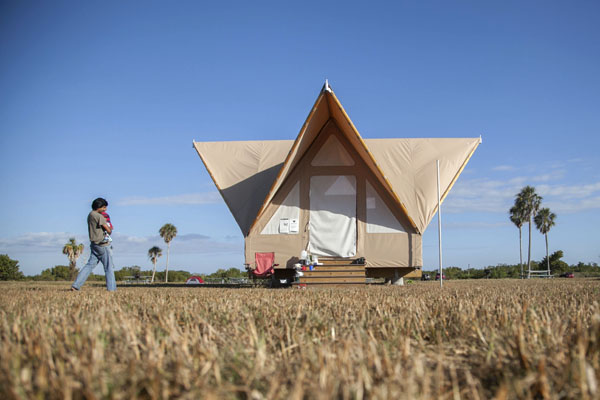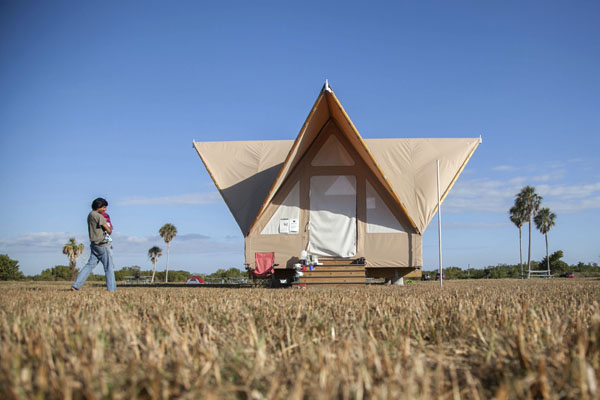
Second-year graduate student Ruslana Makarenko plans on driving down to Everglades National Park and staying in the eco-tent provided at Flamingo Campground sometime in the near future.
If she does, she will be intimately familiar with the wooden platform, fabric canvassing and steps of the shelter — she was one of 11 students from the School of Architecture who designed and built it.
Under the direction of professors Rocco Ceo and Jim Adamson, fifth-year seniors and graduate students created the eco-tent as part of their design/build studio class in the spring of 2011.
“Studios don’t usually offer hands on stuff,” Makarenko said. “You got to put into practice what you’re supposed to be learning in school. It was a once-in-a-lifetime opportunity.”
The lone eco-tent is a prototype for possible overnight accommodations, something the park has not offered since Hurricanes Andrew and Wilma devastated the 103-room Flamingo Lodge that once stood.
“We decided it was important to show the public that we could actually make progress,” said Everglades National Park Superintendent Dan Kimball in a video produced by University Communications.
Armed with a grant from South Florida National Parks Trust, park officials reached out to the UM School of Architecture to create a shelter that would provide practical, sustainable lodging for visitors.
According to an article in the Huffington Post, the original plan was to build 40 units, but finances and logistics stand in the way.
The eco-tent is available for overnight booking through April 14 and can be reserved for up to three nights, according to the National Park Service website. The interior offers room for four adults and houses bed frames, a table and chairs.
Regardless of how plans progress, the students involved walked away with real-world experience and a better understanding of what it takes to work for a client.
“You get more communication skills and bigger appreciation for the whole process and the fact that architecture is more of a service,” said Giancarlo Belledonne, a second-year graduate student.
For these aspiring architects, the portfolio addition and interview talking point was an extra bonus.
“A lot of people only have digital work,” Belledonne said.
With plenty of guidance from Ceo and Adamson, students met three times a week to design, pitch, order materials and build — from imagination to reality in one semester.
According to Makarenko, the intense design period provided a lesson in compromise, respect and group work.
“We had things as diverse as using a storage container,” Makarenko said. “People were very set on their ideas and had to overcome their differences.”
Ultimately, the students ended up with a 200-square-foot tent made of wood and fabric that sits on a 2-foot platform. It can be disassembled and stored during the area’s most vulnerable time – hurricane season.
Indicated by the term “eco-tent,” there was also an emphasis on sustainability, low environmental impact and use of natural materials. The floor decking is made of bamboo and recycled plastic.
Once their design was approved, the students picked up their tools and moved forward to construction.
“That was the fun part,” Belledonne said.
Makarenko noted that, as students who spend most of their time designing digitally, building was a learning process. She recalled the first day of construction, when one student threw down a concrete panel and it broke.
“You learn it’s good to order one extra of everything,” she said.
For Belledonne, designing the eco-tent was one thing, but seeing it materialize in front of him was another.
“I thought it was interesting because seeing something on a computer screen — you can’t picture it,” he said. “It was a lot bigger than I thought it would be.”






